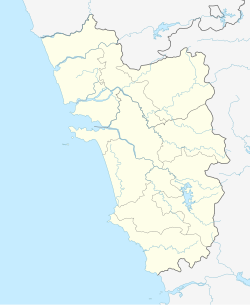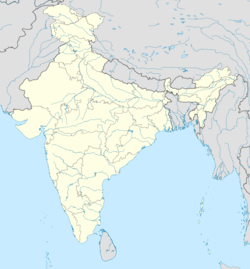This article needs additional citations for verification. (August 2024) |
Cuncolim is a town in South Goa district in the state of Goa, India.
Cuncolim | |
|---|---|
| Coordinates: 15°10′12″N 73°58′48″E / 15.17000°N 73.98000°E | |
| Country | |
| State | |
| District | South Goa |
| Sub-district | Salcete |
| Government | |
| • Type | Council |
| • MLA | Yuri Alemao |
| • Chairperson | Laxman Naik |
| Elevation | 13 m (43 ft) |
| Population (2011) | |
• Total | 16,623[1] |
| Languages | |
| • Official | Konkani |
| Time zone | UTC+5:30 (IST) |
| PIN | 403703 |
| Vehicle registration | GA-08 |
Geography
editCuncolim is located at 15°10′N 73°59′E / 15.17°N 73.98°E. It has an average elevation of 13 m (43 ft).[2]
History
editIt is a former village, now with a municipal council of its own, in the south Goa sub-district (taluka) of Salcette, India. It is part of the AVC (Assolna-Velim-Cuncolim) network of villages.
Historically, there are twelve Vangodds (clans) of Ganvkars (landlords) in the village. Their names, in order of precedence, are as follows: Mhal, Shetcar, Naik, Mangro, Shet, Tombddo, Porob, Sidakalo, Lokakalo, Bandekar, Rounom and Becklo.[3]
Cuncolim was the site of the Cuncolim revolt in 1583. Those killed on the Christian side included five Jesuits who were later beatified as the "Martyrs of Cuncolim".[4]
The village of Cuncolim was the original site of the famous temple of Shree Shantadurga before almost all the villagers converted to Christianity and the temple was demolished.[5] The few remaining Hindu families took the idol of Shree Shantadurga to Fatorpa where the new temple of Shree Shantadurga Cuncolikarin stands today.[6]
Demographics
editCuncolim has population of 16,623 (7,924 males, 8,699 females) with 50.42% being Hindu, 37.58% Christian, and 11.82% Muslim as per reports released by India’s Population Census 2011.[1] Other religious minorities are present in trace numbers.
The village’s native Christian community consists of Goan Catholics originating from Kshatriya noblemen, known as Chardo, presently numbering 3000.[7]
Cuncolim also houses a Scheduled Tribe community of 738 and a Scheduled Caste population of 157 individuals as per Population Census 2011.
Education
editCuncolim is home to National Institute of Technology Goa, an autonomous institution in western India of national importance. It is one of the 31 N.I.T.s in the country. Cuncolim has 5 high schools namely Our Lady of Health, Cuncolim United, Infant Jesus, Maria Bambina Convent and St. Anthony High School (formerly known as Hutatma Rajanikant Kenkre Memorial High School). Higher secondary needs are catered to by Maria Bambina and United Higher secondary, former has Arts and Commerce stream whereas latter has both the streams in addition to Science. Cuncolim United College is the only college in Cuncolim which mostly has students from areas surrounding Cuncolim and also there is Graduation College namely Cuncolim Education Society of Arts and Commerce which provides Degree Course of B. A and B. COM for students of Cuncolim and surrounding areas . Prabal's Institute of Commerce and Computer Education has been imparting typing and computer skills for the last 25 years.
Culture
editCuncolim has a unique traditional village irrigation, involving 12 bunds (water-gathering centres). It has also 12 residential clans (or "vangodds"). Cuncolim Union is one of the social organisations formed by people of this area.
Government and politics
editCuncolim is part of Cuncolim (Goa Assembly constituency) and South Goa (Lok Sabha constituency).
Places of interest
editCuncolim is home to the Molanguinim Cave, small waterfalls and the Nayaband Lake.[8]
See also
editReferences
edit- ^ a b C. Chandramouli (2015) [2010–11], "Cuncolim Population Census 2011", Office of the Registrar General and Census Commissioner, India, Government of India, Census Organization of India, retrieved 6 July 2017
- ^ "Cuncolim, India Page", Falling Rain Genomics, Inc, retrieved 6 July 2017
- ^ Rowena Robinson (15–21 February 1997), "Cuncolim: Weaving a Tale of Resistance", Economic and Political Weekly, 32 (7), Economic and Political Weekly: 334–340, JSTOR 4405091
- ^ D'Souza, Anthony X. (1913). . In Herbermann, Charles (ed.). Catholic Encyclopedia. New York: Robert Appleton Company.
- ^ Sarasvati's Children: A History of the Mangalorean Christians, Alan Machado Prabhu, I.J.A. Publications, 1999, p. 103.
- ^ Goa's First Revolt Against Portuguese Rule in 1583 Archived 4 March 2016 at the Wayback Machine.
- ^
Shiv Kumar, "Caste rivalry threatens to disrupt harmony in Goa", The Indian Express, Panaji, archived from the original on 10 October 2012, retrieved 6 July 2017,
The Catholic Gaonkars, Kshatriyas by caste, have always had an uneasy relationship with the backward castes. Despite their small numbers, around 3,000 in a community of 20,000, the Gaonkars have traditionally monopolised the Confraria do Santissimo Sacramento and Nossa Senhora de Saude (Confraternity of Most Blessed Sacrament and Our Lady of Health), a body which celebrates feasts, processions and other religious ceremonies.
- ^ "Sappu and Nayaband lake issues to be challenged in NGT - India Environment Portal | News, reports, documents, blogs, data, analysis on environment & development | India, South Asia". www.indiaenvironmentportal.org.in. Retrieved 29 July 2018.
External links
edit- Cuncolim on GoaHolidayHomes.com

